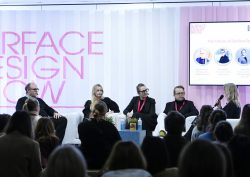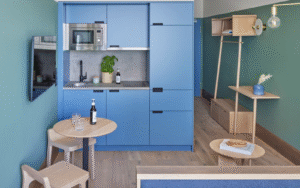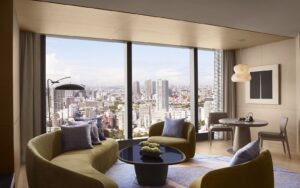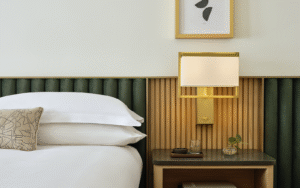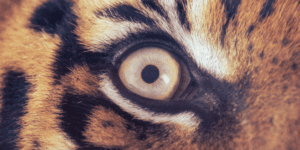Grand architectural gestures may be what makes the design headlines, but it is often the surfaces within that make the difference and elevate a room or a space by adding layers, tones and textures. Writer Pauline Brettell takes a look back at some of the surface design products that have made a mark this year…
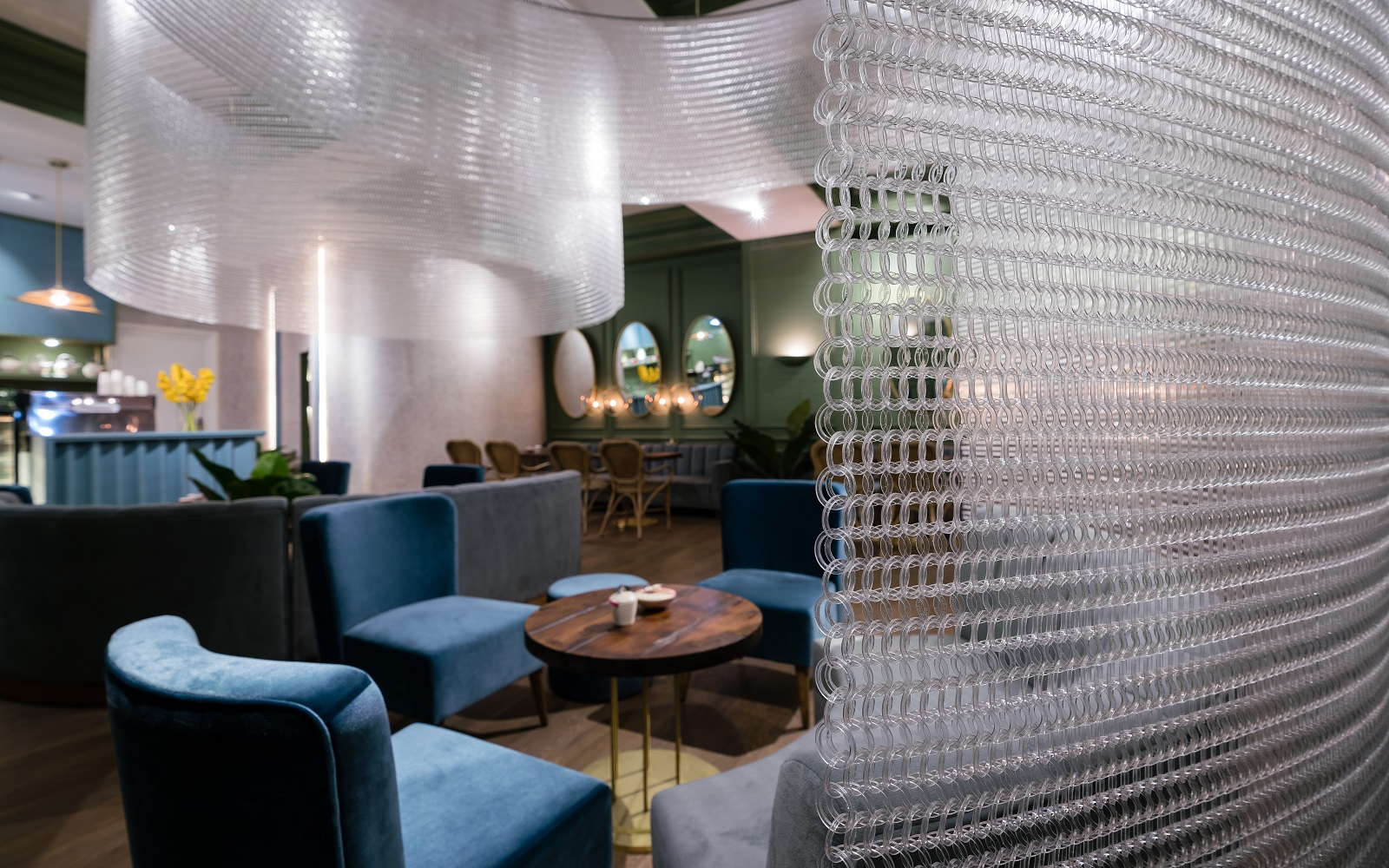
Surface design ranges from the purely pretty through to the frankly functional side of design. What has been exciting over the year is seeing new products, many with a focus on innovative and sustainable materials and production being championed by both designers and manufacturers. This is also a realm that has benefitted from collaboration, as design and manufacture merge to create exciting new products to inspire and change the shape of things to come.
One of these products that literally is a shape shifter comes from Kaynemaile, and is all about creating boundaries without actually requiring any building blocks — instead it is designed as an extremely strong yet highly flexible architectural modern mesh consisting of interlinked polycarbonate rings formed together by a unique liquid-state assembly process – a process which enables seamless mesh screens of any height and width to be fabricated. It is a versatile design element which can accommodate a range of design applications while lending an impactful, sculptural aesthetic to any interior.
Inspired by centuries-old medieval chainmail used for armour, Kaynemaile’s origins can be traced back to the film set for The Lord of The Rings trilogy. The film’s art director for the Creatures, Armour and Weapons department – and Kaynemaile’s founder – Kayne Horsham developed a lightweight, manually assembled version of traditional chainmail made from polypropylene piping. This lightweight material looked and moved realistically and allowed the cast to work in chainmail costumes for extended periods. After filming finished, Horsham continued his work with chainmail, perfecting a liquid state assembly process to mass produce the first polycarbonate chainmail for architectural applications.
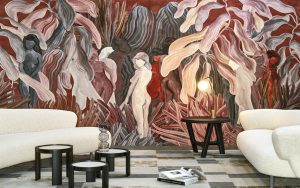
Image credit: Arte
Earlier this year Arte expanded its wallcovering collection Décors & Panoramiques with a collection of designs that immerse the viewer in a series of enticing stories and intriguing fairy-tales.The new designs in the Arte Décors & Panoramiques collection transport you both geographically and imaginatively. With wallcoverings referencing locations from Tibet to Italy to the fiery lines of a Brazilian dance you can travel the world in seven designs. Alternatively, you can go on a journey of the imagination as mysterious fairy-like figures invite you into the panorama. The strength of these designs is not only in the surface patterns, but also in the materials that have been used, which include velvety soft silks, textured boucle fabrics and sophisticated linen effects.
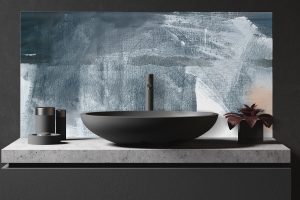
Image credit: Red Dog Glass Design
Red Dog Glass Design breathed fresh ideas into the world of surface design with the launch of Inhale, a series of designs in a range of inspired glass panels focussing on the restorative power of the breath. Based on the original artwork of company founder Sally Coulden, the Inhale range of glass panels is an observation on the expansiveness of the landscape, particularly from the summits of the brooding British hills. The artwork is then expertly applied to high-quality glass panels. Durable, practical and beautiful, each unique piece can be installed as high-end contemporary art panels or as glass splashbacks, in a range of commercial and residential settings. All of the designs tell a story, and create visual impact. Whether as a panel in a bathroom or a statement piece in public areas such a lobbies and restaurants, a piece of Red Dog glass will elevate any space into something extraordinary.
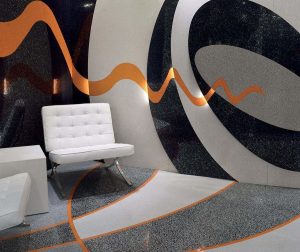
Image credit: TREND Group
Continually working on innovative surface solutions, the etherium By E-Stone solid surfaces from TREND, are made with up to 72 per cent recycled glass. TREND was the first company to combine recycled beer, wine, and mineral water bottles with polymer technology. Today, the company uses 7.5 million tons of recycled glass each year, greatly reducing their carbon emissions. And the sustainable story continues with the brands signature glass mosaics. Whilst employing centuries old artisan techniques TREND makes use of modern technology to make their products as environmentally friendly as possible. Their signature blue glass for example is made from upcycled SKYY Vodka bottles.
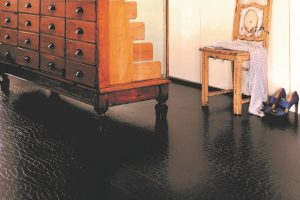
Image credit: GranorteUsing cork to provide underfoot comfort, thermal insulation and acoustic absorption; Granorte has created a unique luxury floor with the capability to add something very special to interiors. The 100 per cent recycled genuine leather finish is available in a range of finishes – the the mock-croc of Veneto, grained Umbria and elegant Lombardia, are each offered in a palette of dark, sophisticated tones. Granorte uses a 2mm thick piece of recycled leather for Corium and uses cork to enhance performance. A high-density fibreboard core lets Granorte use Uniclic joint for fast and easy glue-free installation. The cork integrated underlay has Microban technology to inhibit the growth of bacteria and the floor is available in two formats – a rectangular tile and plank. The leather surface of Corium is protected with Granorte’s AQUA2K+, a water-based performance coating that enhances wear resistance and makes maintenance easier. Corium is a luxury flooring option that comes with excellent environmental credentials.
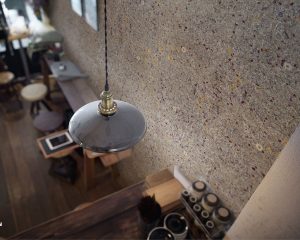
Image credit: Architextural
Launched earlier this year, the Avery Dennison Organoid from Architextural provides a natural, eco-positive design solution, and includes seven finishes, three of which are translucent films suitable for window application. The four solid films in the collection are Moss Bright Green, Moss Dark Green, Original Alpine Hay, and Mountain Hay and Marguerites. The three translucent films include Rose Petals, Sunflower Petals, and Skellett Leaves. The Organoid Natural Surfaces range is made from organic and regionally produced raw materials, often reusing ingredients that are a by-product of others, including things like alpine hay, sunflower petals and even real moss.
Rather than processing the material through conventional production processes, these natural materials are mixed by hand with an ecological binding agent and pressed together onto a self-adhesive tape, resulting in a thin, compact film layer. The film is practically emissions-free and allergy tested, meaning it’s free from any subsequent ecological health concerns.
The Surface Design Show earlier this year provided a platform with the aim to ‘bring surfaces back to life’, and the plethora of innovative products that have been designed, produced and manufactured over the course of the year would lead one to assume that surfaces are indeed alive and well, shifting boundaries and challenging preconceptions as in many cases it is the realm in which material innovation is at the forefront.
Main image credit: Kaynemaile







